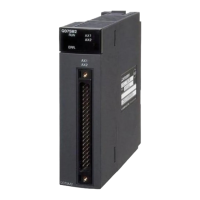9 - 2 9 - 2
MELSEC-Q
9 TROUBLESHOOTING
(3) When count cannot be started or normal count cannot be made
Check item Corrective action
Is the terminal block external wiring normal?
Refer to Section 3.5, and check and correct the external
wiring.
Does the pulse input wiring use a shielded
twisted pair cable?
Use a shielded twisted pair cable for the pulse input wiring.
Is noise entering from the module grounding
section?
Separate the module's ground cable.
If the module's case is contacting the grounding section,
detach it.
Have noise preventive measures been taken
inside the panel and for adjacent equipment?
Take noise preventative measures such as attaching a CR
surge suppressor to a magnet switch.
Noise
preventive
measure
Is there sufficient clearance between high
voltage equipment and pulse input lines?
Wire the pulse input line independently inside the panel,
separate the pulse input line from the power line by at least
150 mm (5.9 in) as a guideline.
Is the "CH " LED lit when a voltage is applied to the pulse
input terminal by a stabilized power supply or similar?
If the LED lights up, check the external wiring and the pulse
generator side and make necessary corrections.
If the LED is not lit, the possible cause of a module fault.
Contact the nearest branch office or agency with a details of
the occurring problem.
Does the "input voltage selection" in setting with the
intelligent function module switch match the actual input
pulse voltage.
Correct the "input voltage selection" in setting with the
intelligent function module.
Is the edge (rise/fall) of the counted pulses correct?
Check whether pulses are counted on the rise or fall, and
correct the "pulse edge selection" in setting with the intelligent
function module.
Is the maximum speed of input pulses within the range of
the counting speed set to the "input filter setting" in setting
with the intelligent function module?
Correct the "input filter setting" in setting with the intelligent
function module to match the maximum speed of input
pulses.
Does the input pulse waveform satisfy the performance
specifications?
Observe and check the pulse waveform with a synchroscope
or similar, and if the input pulses do not satisfy the
performance specifications, enter the input pulses that satisfy
the performance specifications.
If the "accumulating count value" or "input pulse value" of
the buffer memory read on a two-word (32-bit) unit when it
is read in the sequence program?
Read two words together.
Are the count values on multiple channels the same when
the same pulse is input to the multiple channels?
If the count values are different, the possible cause is a
module fault. Contact the nearest branch office or agency
with a details of the occurring problem.
Is the count enable (Y18 to Y1F) ON?
Turn the count enable (Y18 to Y1F) ON using a sequence
program.
Is the "overflow detection flag" of the buffer memory* "1"?
Set "1" in the "counter reset request" of the buffer memory* to
reset the counter.
Is the "pre-scale setting value" of the buffer memory* "0"?
Set a value other than "0" in the "pre-scale setting value" of
the buffer memory*.
*: Refer to Section 3.4 for details of the buffer memory.
9

